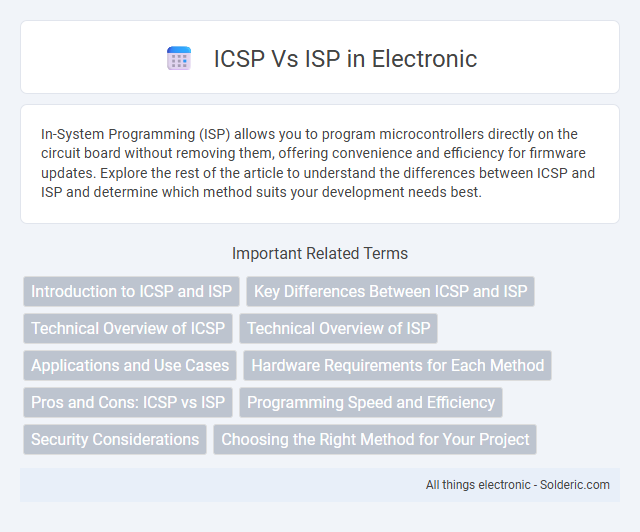In-System Programming (ISP) allows you to program microcontrollers directly on the circuit board without removing them, offering convenience and efficiency for firmware updates. Explore the rest of the article to understand the differences between ICSP and ISP and determine which method suits your development needs best.
Comparison Table
| Feature | ICSP (In-Circuit Serial Programming) | ISP (In-System Programming) |
|---|---|---|
| Definition | Programming microcontrollers directly on the circuit board via a dedicated header. | Programming devices while installed in their target system, usually through standard interfaces. |
| Purpose | Firmware updating without removing the microcontroller from the PCB. | Allows programming or updating firmware on devices integrated within systems. |
| Hardware Interface | Usually a 5-pin header (MCLR, Vcc, GND, PGD, PGC) specific to PIC microcontrollers. | Interfaces vary by device: SPI, JTAG, USB, UART, or other communication protocols. |
| Supported Devices | Primarily Microchip PIC microcontrollers. | Widely supports various microcontrollers, FPGAs, and embedded devices. |
| Programming Speed | Moderate, limited by serial communication protocol and header pin count. | Varies based on interface type; some ISP protocols support high-speed transfers. |
| Use Case | Development and field firmware updates for PIC microcontroller boards. | General embedded system programming, device manufacturing, or firmware upgrades. |
| Advantages | Simplifies programming on PIC devices without extra equipment. | Flexible and universal method supporting multiple device types and protocols. |
| Limitations | Limited to PIC microcontrollers; requires specific ICSP header layout. | Requires compatible interface and may need device-specific programming tools. |
Introduction to ICSP and ISP
ICSP (In-Circuit Serial Programming) and ISP (In-System Programming) are methods used to program microcontrollers directly on a circuit board without removing the chip. ICSP typically involves a specific programming header and protocol designed for certain microcontroller families, providing efficient firmware updates during development or production. Your choice between ICSP and ISP depends on the microcontroller compatibility and the required programming environment for seamless embedded system development.
Key Differences Between ICSP and ISP
ICSP (In-Circuit Serial Programming) and ISP (In-System Programming) both enable programming microcontrollers directly on the circuit board but differ mainly in their application and hardware requirements. ICSP typically requires fewer pins and is used for programming PIC microcontrollers through a dedicated 5-pin header, while ISP can support a broader range of microcontrollers with more flexible interfacing options. Your choice between ICSP and ISP should consider the specific microcontroller compatibility, available board space, and programming convenience needed for your project.
Technical Overview of ICSP
ICSP (In-Circuit Serial Programming) enables programming microcontrollers directly on the circuit board through a dedicated set of pins, streamlining firmware updates without the need for removal. It typically involves protocols such as SPI or JTAG, allowing high-speed serial communication between the programmer and the microcontroller's memory. Your development process benefits from ICSP's ability to facilitate debugging and rapid iteration while maintaining circuit integrity.
Technical Overview of ISP
In-System Programming (ISP) enables microcontrollers to be programmed directly within the end system, utilizing standard interfaces like SPI, UART, or JTAG, which eliminates the need for removal from the circuit. ISP supports firmware updates, debugging, and testing without hardware modification, enhancing development flexibility and reducing production costs. Your embedded system benefits from faster deployment times and streamlined maintenance through ISP's seamless integration with the microcontroller's programming interface.
Applications and Use Cases
ICSP (In-Circuit Serial Programming) is ideal for programming microcontrollers directly on a PCB during manufacturing or development, enabling firmware updates without removing the chip. ISP (In-System Programming) supports broader use cases, such as updating firmware in embedded systems already deployed in the field, allowing You to maintain and upgrade products remotely. Both methods streamline device programming but ICSP excels in controlled environments, while ISP maximizes flexibility for ongoing maintenance.
Hardware Requirements for Each Method
ICSP (In-Circuit Serial Programming) requires a dedicated programming header on the PCB with specific pins for power, ground, clock, data in, and data out, enabling programmers to reprogram microcontrollers without removal. ISP (In-System Programming) hardware demands a minimal interface, often just SPI or UART connections, allowing you to program the device while it remains in the final system. Your choice between ICSP and ISP hardware depends on the microcontroller type and design constraints, with ICSP typically needing more pins and specialized connectors than ISP.
Pros and Cons: ICSP vs ISP
ICSP (In-Circuit Serial Programming) enables on-board microcontroller programming without removing the chip, offering convenience and faster firmware updates but may risk damage due to exposed connections. ISP (In-System Programming) allows programming within the system environment, supporting flexibility for debugging and development, yet sometimes requires additional hardware or complex setup. ICSP generally suits streamlined production, while ISP provides more versatility for iterative design and troubleshooting.
Programming Speed and Efficiency
ICSP (In-Circuit Serial Programming) generally offers faster programming speeds compared to ISP (In-System Programming) due to direct access to microcontroller pins without needing a separate programmer interface. ICSP improves efficiency by minimizing setup time and enabling rapid firmware updates, especially in development environments. Your workflow benefits from ICSP's streamlined process, reducing programming overhead and accelerating debugging cycles.
Security Considerations
ICSP (In-Circuit Serial Programming) and ISP (In-System Programming) both facilitate programming microcontrollers, but security considerations differ significantly. ICSP often requires direct physical access to the programming pins, increasing the risk of unauthorized reprogramming or tampering during debugging or development. ISP, leveraging embedded bootloaders and secure communication protocols, offers enhanced protection against firmware attacks and unauthorized access, making it more suitable for secure field updates and embedded system applications.
Choosing the Right Method for Your Project
Choosing the right programming method depends on project requirements, hardware compatibility, and development environment. In-Circuit Serial Programming (ICSP) offers direct microcontroller programming on the PCB, ideal for faster debugging and modifications during prototyping. In-System Programming (ISP) supports firmware updates post-production without hardware removal, making it suitable for projects requiring in-field updates and long-term maintenance.
ICSP vs ISP Infographic

 solderic.com
solderic.com